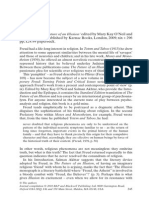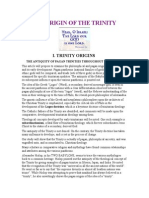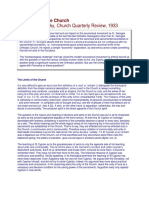Moses and Civilization - The Meaning Behind Freud's Myth
Moses and Civilization - The Meaning Behind Freud's Myth
Uploaded by
RadoslavCopyright:
Available Formats
Moses and Civilization - The Meaning Behind Freud's Myth
Moses and Civilization - The Meaning Behind Freud's Myth
Uploaded by
RadoslavOriginal Description:
Copyright
Available Formats
Share this document
Did you find this document useful?
Is this content inappropriate?
Copyright:
Available Formats
Moses and Civilization - The Meaning Behind Freud's Myth
Moses and Civilization - The Meaning Behind Freud's Myth
Uploaded by
RadoslavCopyright:
Available Formats
Book Reviews
PAUL, ROBERT A. Moses and Civilization: The Meaning behind Freud's Myth. New Haven, Conn., and London: Yale University Press, 1996. 268 pp. $32.50 (cloth). While there is no dearth of accomplished Freud exegesis in Robert A. Paul's Moses book, its main concern is not so much the re-productive task of interpretation as it is the productive task of showing how Freud's ideas can be fruitfully extended. By "rectifying certain missteps" in Freud's argumentation, Paul hopes "to reawaken interest" in a "great mythic matrix": the slaying of a hated-and loved-primal-horde father by his brutalized sons, their guilt, remorse, and covenantal renunciation that inaugurates "a new social system" resting on "prohibitions against incest and murder . . . instituted" to abrogate the primal-horde system (pp. 1, 3). Freud's "missteps" presuppose "dubious historical and ethnographic 'facts'," "outmoded cultural evolutionism," "direct inheritance" of "repressed complexes," and "the central analogy": "a civilization is like a person." Paul's critical responses are "constructive," using Freud to improve on Freud, specifying Freud's generalities, simplifying, structuring, and reconstructing his arguments (pp. 3, 9, 10-12, 152-59, 172-74). Retracing "Freud's path of reasoning" and working backward from the Eucharist, Paul reconstructs Freud's talionic reconstruction of the "killing of the primal father," a "mythic narrative" whose textual-historical relevance is latent in the manifold ways it is replicated in the Torah, the "heart of Jewish worship" and "foundation for the Christian tradition as well." Making latent patricide manifest requires the horde's analysis as a "Darwinian triadic structure" (senior malejunior male-female) as well as analysis of obsessional "defensive strategies" like "reaction-formation," "splitting," "isolation," "intellectualization," and "doing and undoing." These structural-anthropological-psychoanalytical tools yield a tripartite division of the Torah reflecting three stages of the primal-horde myth: (1) "the regime of the primal horde" = "the era of Israelite bondage . . . under Pharaoh"; (2) "the rebellion by the band of brothers" = "the rebellion against the pharaoh of Egypt"; (3) "the establishment of the new order . . . prohibition against incest and murder . . . . deification of the slain fatherltyrant" = "revelation of the Law at Mount Sinai" (pp. 5-12, 20, 24, 150, 12-13; cf. on "deification" pp. 118-1 9, 185-86). Leviticus, Numbers, and Deuteronomy continue and elaborate the Sinaitic "establishment of a new, 'civilized' form of life," and Genesis provides an "overture to the central narrative." Its "mythic stories" vary "a few central underlying themes," imaging "terms and relations out of which the . . . overarching myth is to be constructed." Genesis also affords a mythicocosmic1mythicohistorica1 context for Moses, the culture hero-to-come, most immediately by its "happy ending" in a "state of harmony"; "conflict and estrangement" between family members, between peoples, between Pharaoh and Israel, are displaced by "respect and affection"-"before the fall [!] into the Freudian primal-horde situation" (pp. 13-14). Thus, Paul divides the "combined Judeo-Christian biblical myth" into (1) an overture culminating in "a harmonious state of society," Israel "under the good pharaoh," followed by; (2) "the regime of a bad pharaoh" = Freud's "paradigm of the 'bad' primal horde"; (3) [Moses'] "rebellion against this regime"; (4) "a covenant based on shared guilt in the rebellion"; (5) [Christ's] "second rebellion"; and (6) "a new covenant," taking "as its model of society the oppressed but united band of brothers living in harmony and love" (p. 214).
The Journal of Religion
The larger configurations traced by Paul's structural-anthropological-psychoanalytical methods contain fertile analyses of more limited structures, including: the Egyptian triad + (Isis-Osiris-Horus Seth), the primaeval pastoral triad + (ewes-rams-nonbreeding males + herdsman) or double dyad (ewes-rams, nonbreeding males-herdsman), and the biblical double dyads (Joseph-Moses, good pharaoh-bad pharaoh); "social practices" in pre-Sinaitic times as "the antithesis of what becomes normative" post-Sinai, especially in re incest; God's prohibition against Moses' entering Canaan as grounded in "pre-oedipal demand for the breast." Finally, Paul's psychoanalytic comparison of Moses and Jesus ("like" and yet "antithetical") lies at the heart of his concluding juxtaposition of Christianity and Judaism: Moses, guilty [father-] son, offers the Law and its commandments, a system of "painful self-reproaches" and "self-control," as "primary defenses" against the guilt of primal rebellion; Jesus, innocent son [-father], offers himself in love and faith, as a "system of secondary defenses," not only against the guilt of primal rebellion, but also-and primarily-against the "set of self-reproaches" embodied in "the Mosaic Laws" (pp. 30-40, 59-64, 61-70, 106: "the waters of Meribah," 2 15-1 8). Paul's tour de force, interweaving structural anthropology and psychoanalysis, Judaeo-Christian and cultural-civilizational studies generally, will surely evoke much discussion, perhaps even a little controversy. It would be surprising if work of this depth, quality, and originality failed to do so. The book is marked by clarity, sobriety, and modesty (cf., e.g., pp. 14 below to 15 above), traits of intellect and character that recall the model of Freud himself. This brief review presents a few selected highlights, nothing remotely approaching the wealth of insight and stimulation in Paul's book. I hope I have at least conveyed something of its humanistic engagement with fundamental issues, its author's hope: "To have demonstrated that Freud's myth of the primal horde and the story of Moses as told in the Torah are one and the same, to have drawn out some of the implications of this identity, and to suggest that inquiry based on the recognition of it will lead toward a richer understanding of who we are and what we are doing" (p. 221). SAMUEL PI JAFFE, CTniversitjof Chicago.
You might also like
- Jeffrey Cohen Monster Theory Reading CultureDocument47 pagesJeffrey Cohen Monster Theory Reading CulturePaula Pepe100% (2)
- The Social History of Satan, Part II PDFDocument42 pagesThe Social History of Satan, Part II PDFNovi Testamenti FiliusNo ratings yet
- Utopias and The MillenniumDocument176 pagesUtopias and The MillenniumRadoslav100% (4)
- Paul As Herodian (1996)Document9 pagesPaul As Herodian (1996)Arturo CampilloNo ratings yet
- Maslow's Hierarchy How The "House of Cards" CrumblesDocument66 pagesMaslow's Hierarchy How The "House of Cards" Crumblesken jacobsenNo ratings yet
- American Fascists: The Christian Right and the War On AmericaFrom EverandAmerican Fascists: The Christian Right and the War On AmericaRating: 4 out of 5 stars4/5 (228)
- Philippine Accounting Standards 38 (Intangible Assets2)Document72 pagesPhilippine Accounting Standards 38 (Intangible Assets2)Princess Edreah NuñalNo ratings yet
- Shards of CombatDocument14 pagesShards of CombatLord SkywalkerNo ratings yet
- Book Edcoll 9789047432494 Bej.9789004164246.I-247 010-PreviewDocument2 pagesBook Edcoll 9789047432494 Bej.9789004164246.I-247 010-PreviewAnbu ArasanNo ratings yet
- Gnostics Yahweh and Cosmic Mid East WarDocument23 pagesGnostics Yahweh and Cosmic Mid East WarpoyataNo ratings yet
- Specters of PaulDocument109 pagesSpecters of PaulNikos VassilopoulosNo ratings yet
- THOMPSON, E.P. Anthropology and The Discipline of Historical Context PDFDocument15 pagesTHOMPSON, E.P. Anthropology and The Discipline of Historical Context PDFRafael SilvaNo ratings yet
- Postmodern PostsecularDocument16 pagesPostmodern PostseculardcaguenasNo ratings yet
- ¡YES, YOU SHOULD BELIEVE IN THE TRINITY (Ch. 3), Christina R. Darlington, 2013Document21 pages¡YES, YOU SHOULD BELIEVE IN THE TRINITY (Ch. 3), Christina R. Darlington, 2013Dante A. UrbinaNo ratings yet
- 1996 1 Ryabov35 1Document4 pages1996 1 Ryabov35 1John VandevertNo ratings yet
- Lectures, 1981.: Norman O. Brown. The Challenge of Islam: The Prophetic TraditionDocument5 pagesLectures, 1981.: Norman O. Brown. The Challenge of Islam: The Prophetic TraditionJack LintNo ratings yet
- Are The Gospels Mythical - René GirardDocument5 pagesAre The Gospels Mythical - René GirardSamuel SantosNo ratings yet
- Filon On WomenDocument33 pagesFilon On WomenMartaNo ratings yet
- Role of Women in The History of Christianity Role of Early Church Fathers Towards WomenDocument4 pagesRole of Women in The History of Christianity Role of Early Church Fathers Towards WomenKamlesh PeterNo ratings yet
- Satan in The New Testament GospelsDocument43 pagesSatan in The New Testament GospelsBaciu LaurențiuNo ratings yet
- British Journal of Psychotherapy Volume 26 Issue 2 2010 (Doi 10.1111/j.1752-0118.2010.01178 - 3.x) Linda Pethick - Mind Works - Technique and Creativity in Psychoanalysis - by Antonino FerroDocument17 pagesBritish Journal of Psychotherapy Volume 26 Issue 2 2010 (Doi 10.1111/j.1752-0118.2010.01178 - 3.x) Linda Pethick - Mind Works - Technique and Creativity in Psychoanalysis - by Antonino FerroJulián Alberto Muñoz FigueroaNo ratings yet
- Morality Play FaustusDocument9 pagesMorality Play Faustusfireshade82No ratings yet
- 1993 - Baring & Cashford - Thank GoddessDocument5 pages1993 - Baring & Cashford - Thank Goddessbuster301168No ratings yet
- 9789004275942-B9789004275942-s006Document11 pages9789004275942-B9789004275942-s006Edmond TsuiNo ratings yet
- 456a Source of Prudentius' PsychomachiaDocument5 pages456a Source of Prudentius' PsychomachiaRodrigoNo ratings yet
- The Social History of Satan - The Intimate EnemyDocument24 pagesThe Social History of Satan - The Intimate EnemyCatalina CatalinaNo ratings yet
- Are The Gospels MythicalDocument27 pagesAre The Gospels MythicalVinicius AlbernazNo ratings yet
- Gibeon Had Made Peace With IsraelDocument16 pagesGibeon Had Made Peace With IsraelAlexandre GonçalvesNo ratings yet
- Review and Reaction, E.P. SandersDocument15 pagesReview and Reaction, E.P. Sandersmung_khatNo ratings yet
- RBJ DWX HMUa X4Document371 pagesRBJ DWX HMUa X4Delia Dascalu0% (1)
- Fallenangel Flyer For Business CardsDocument17 pagesFallenangel Flyer For Business Cardsapi-231612881No ratings yet
- Chapter NO. 2 Literature Review of DR - Faustus 2.1 Literature Review About The Morality in PlayDocument11 pagesChapter NO. 2 Literature Review of DR - Faustus 2.1 Literature Review About The Morality in PlayAdeena ImranNo ratings yet
- History of CatholicismDocument11 pagesHistory of CatholicismaivddNo ratings yet
- Russell 1993Document22 pagesRussell 1993Farzad HNo ratings yet
- Apostolic CollectionsDocument126 pagesApostolic CollectionsRoss100% (1)
- Dr. Faustus Act 1, Scene 1 Analysis of ContextDocument3 pagesDr. Faustus Act 1, Scene 1 Analysis of ContextEndonezyalı AdamNo ratings yet
- The Faustian Motif in Christopher Marlowe'S: Dr. FaustusDocument14 pagesThe Faustian Motif in Christopher Marlowe'S: Dr. FaustusSheldon CooperNo ratings yet
- Trinity OriginsDocument15 pagesTrinity OriginsSteve-O100% (1)
- Wyrd, Causality and Providence A Speculative Essay (McNish)Document10 pagesWyrd, Causality and Providence A Speculative Essay (McNish)Xander CarrNo ratings yet
- Milton Chaos and Paradise Lost PDFDocument13 pagesMilton Chaos and Paradise Lost PDFBen GlassonNo ratings yet
- Max Rieser The True Founder of ChristianityDocument87 pagesMax Rieser The True Founder of ChristianityAlex BenetsNo ratings yet
- Folklore Into Theory Freud and Levi-Stra PDFDocument20 pagesFolklore Into Theory Freud and Levi-Stra PDFKasey McMurphyNo ratings yet
- JSPES43 3 4 PearsonDocument9 pagesJSPES43 3 4 PearsonGabriel OhwbeNo ratings yet
- Andrew Perriman Corporate PersonalityDocument23 pagesAndrew Perriman Corporate Personalityjhunma20002817No ratings yet
- DR FaustusDocument25 pagesDR Faustusmostafa fatherNo ratings yet
- Supplemental Readings - Session 5 Lesson 4Document60 pagesSupplemental Readings - Session 5 Lesson 4monica.mercadoNo ratings yet
- On EnvyDocument4 pagesOn EnvyMario BaghosNo ratings yet
- Cook, Banjamin, L. ''Freemasonry Condemned From Its Own Sources (Freemasonry Vs Christianity - Phallic Worship of Freemasonry Unveiled) '', 1991.Document93 pagesCook, Banjamin, L. ''Freemasonry Condemned From Its Own Sources (Freemasonry Vs Christianity - Phallic Worship of Freemasonry Unveiled) '', 1991.Stefan_Jankovic_83100% (2)
- PECADO ORIGINAL IASD Zackrison Capitulo 1Document40 pagesPECADO ORIGINAL IASD Zackrison Capitulo 1Maximiliano Andres Caro VargasNo ratings yet
- Gender and Law in The Hebrew Bible PDFDocument14 pagesGender and Law in The Hebrew Bible PDFArnold HailNo ratings yet
- Did Early Christians Practice Same-Sex Rituals.Document10 pagesDid Early Christians Practice Same-Sex Rituals.robwriterNo ratings yet
- Islam and The Unipolar MomentDocument21 pagesIslam and The Unipolar Momentarslan.sultanbekov.ruNo ratings yet
- DassinDocument30 pagesDassinWojciech EngelkingNo ratings yet
- Are The Gospels Mythical - René GirardDocument5 pagesAre The Gospels Mythical - René GirardclaferibNo ratings yet
- Clothes For Spirits: Opening and Closing The Cosmos in Brazilian UmbandaDocument22 pagesClothes For Spirits: Opening and Closing The Cosmos in Brazilian UmbandatrickarleyNo ratings yet
- 08 - Grabowski - Ler - CroppedDocument25 pages08 - Grabowski - Ler - CroppedGessione CunhaNo ratings yet
- Buckley HistoryReligions 2012Document4 pagesBuckley HistoryReligions 2012zheng wangNo ratings yet
- Gluckman 1963-- Gossip and ScandalDocument10 pagesGluckman 1963-- Gossip and Scandalcalvinsun318No ratings yet
- Virginia Burrus: University Financial SupportDocument5 pagesVirginia Burrus: University Financial SupportMarwa SaiedNo ratings yet
- Demon PossessionDocument17 pagesDemon Possessionj.lucas pereiraNo ratings yet
- Myth, Symbol and Reality in The ApocalypseDocument16 pagesMyth, Symbol and Reality in The ApocalypseRadoslavNo ratings yet
- Alain de Benoist - We Are at The End of SomethingDocument7 pagesAlain de Benoist - We Are at The End of SomethingRadoslavNo ratings yet
- US Army Survival ManualDocument277 pagesUS Army Survival ManualRadoslavNo ratings yet
- American Indian CultureDocument1,109 pagesAmerican Indian CultureRadoslavNo ratings yet
- Wurmbrand Richard - Marx - Prophet of Darkness - Communism's Hidden Forces Revealed (1986)Document132 pagesWurmbrand Richard - Marx - Prophet of Darkness - Communism's Hidden Forces Revealed (1986)RadoslavNo ratings yet
- A Guide To Old Testament Theology and ExegesisDocument233 pagesA Guide To Old Testament Theology and Exegesisdvp00793% (14)
- A New Arabic Grammar of The Written Language 1965Document353 pagesA New Arabic Grammar of The Written Language 1965Kollektor100% (11)
- Rewarding Success - Hay Group1Document6 pagesRewarding Success - Hay Group1insta gramNo ratings yet
- Huawei AR Series Access Routers - V200R009 - CLI-based Configuration Guide - Basic ConfigurationDocument464 pagesHuawei AR Series Access Routers - V200R009 - CLI-based Configuration Guide - Basic ConfigurationDenis Alberto Rodríguez GonzálezNo ratings yet
- Eo 226 & Ra 7918Document25 pagesEo 226 & Ra 7918Tet DomingoNo ratings yet
- Story of The Magic HorseDocument3 pagesStory of The Magic Horsewaseemhasan85100% (1)
- Crude Offert CoupDocument3 pagesCrude Offert CoupJuan almeiraNo ratings yet
- Muslim Students in Uk Higher EducationDocument16 pagesMuslim Students in Uk Higher EducationAhmet KarakayaNo ratings yet
- PPTDocument39 pagesPPTSreejith PsNo ratings yet
- Yoshida Shoin Martyred Prophet of Japanese ExpansionismDocument12 pagesYoshida Shoin Martyred Prophet of Japanese ExpansionismNariyyahNo ratings yet
- G. Work Experience ListDocument58 pagesG. Work Experience ListRiyonda SuhalisNo ratings yet
- GF HospitalDocument80 pagesGF HospitalMuhammad Ali DayoNo ratings yet
- Model Test 4Document72 pagesModel Test 4Anika tabassumNo ratings yet
- Adobe Scan 11-May-2024Document5 pagesAdobe Scan 11-May-2024ishika SharmaNo ratings yet
- Ra 6713Document82 pagesRa 6713xed ser100% (1)
- Competition Law AkritiDocument12 pagesCompetition Law AkritiSrijan SinhaNo ratings yet
- Akash Singh's PPT On Tata MotorsDocument18 pagesAkash Singh's PPT On Tata MotorsChaman SinghNo ratings yet
- 03 TASK PERFORMANCE 1 ENTREPDocument8 pages03 TASK PERFORMANCE 1 ENTREPramosmikee112No ratings yet
- Top Strategic Technology Trends in Industrial Manufacturing for 2024 - Shared by WorldLine TechnologyDocument35 pagesTop Strategic Technology Trends in Industrial Manufacturing for 2024 - Shared by WorldLine Technologybaogianxao1405No ratings yet
- Secrets of MCdonaldsDocument16 pagesSecrets of MCdonaldsHeinrich YoNo ratings yet
- Pitfalls To Avoid: OutputDocument7 pagesPitfalls To Avoid: OutputSrivastava MukulNo ratings yet
- Georges Florovsky, The Limits of The Church, 1933Document7 pagesGeorges Florovsky, The Limits of The Church, 1933Constantin BalasoiuNo ratings yet
- MorphemeDocument16 pagesMorphemeasthashukla112003No ratings yet
- Unit Plan Project - A Raisin in The SunDocument61 pagesUnit Plan Project - A Raisin in The SunApril Rose Ilustre100% (2)
- Añǧ A: Kı L /Ǒ L /̞ Ǔň 6 Œ: Urdu Recipes From The Urdu Cookery Immersion DayDocument26 pagesAñǧ A: Kı L /Ǒ L /̞ Ǔň 6 Œ: Urdu Recipes From The Urdu Cookery Immersion Dayanon_29449467350% (2)
- Global InitiativesDocument31 pagesGlobal InitiativesElaine Mae Guillermo EsposoNo ratings yet
- 7 - Detailed PayrollDocument8 pages7 - Detailed PayrollMarc Joshua VillordonNo ratings yet
- Mudarba & MusharkaDocument28 pagesMudarba & MusharkaImran AliNo ratings yet
- EMTech - Q2 - M5 Uploading Managing and Promiting ICT Projects For Social ChangeDocument12 pagesEMTech - Q2 - M5 Uploading Managing and Promiting ICT Projects For Social ChangeVicente priam AribonNo ratings yet
- Elec Workflow PDFDocument1 pageElec Workflow PDFTejas Patel100% (2)
- AAAA ISFM NOTE For NaRMDocument64 pagesAAAA ISFM NOTE For NaRMLemma Deme ResearcherNo ratings yet

































































































